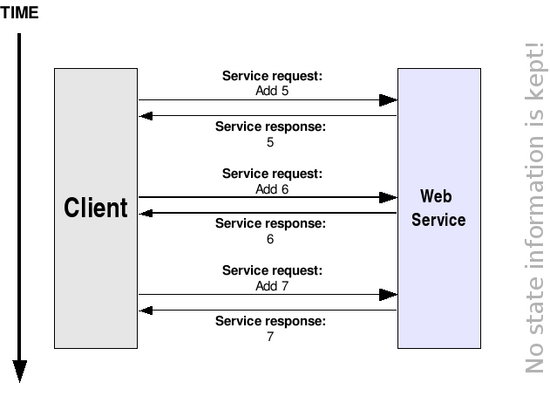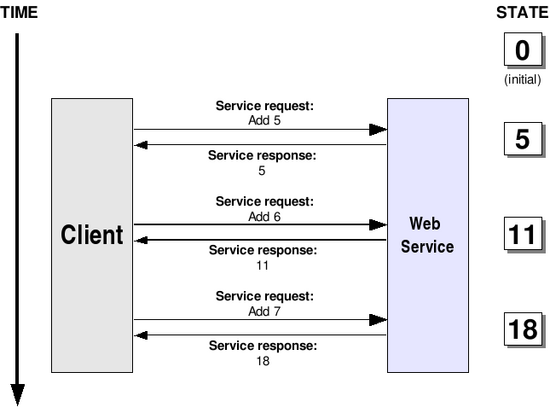As we have just seen, Web Services are the technology of choice for Internet-based applications with loosely coupled clients and servers. That makes them the natural choice for building the next generation of grid-based applications. However, remember Web Services do have certain limitations. In fact, plain Web Services (as currently specified by the W3C) wouldn't be very helpful for building a grid application. Enter WSRF, which improves several aspects of web services to make them more adequate for grid applications.
In this section we'll take a brief look at the different parts of the WSRF specification. However, before doing that, we need to take a close look at the main improvement in WSRF: statefulness.
Plain Web services are usually stateless (even though, in theory, there is nothing in the Web Services Architecture that says they can't be stateful). This means that the Web service can't "remember" information, or keep state, from one invocation to another. For example, imagine we want to program a very simple Web service which simply acts as an integer accumulator. This accumulator is initialized to zero, and we want to be able to add (accumulate) values in it. Suppose we have an add operation which receives the value to add and returns the current value of the accumulator. As shown in the following figure, our first invocation of this operation might seem to work (we request that 5 be added, and we receive 5 in return). However, since a Web service is stateless, the following invocations have no idea of what was done in the previous invocations. So, in the second call to add we get back 6, instead of 11 (which would be the expected value if the Web service was able to keep state).
The fact that Web services don't keep state information is not necessarily a bad thing. There are plenty of applications which have no need whatsoever for statefulness. For example, the Weather Web service we saw in the previous section is a real, working Web service which has no need to know what happened in the previous invocations.
However, Grid applications do generally require statefulness. So, we would ideally like our Web service to somehow keep state information:
However, this is a pretty peculiar dilemma since, as mentioned above, a Web service is usually a stateless entity. In fact, some people might argue that a "stateful Web service" is a bit of a contradiction in terms! So, how do we get out of this jam?
Giving Web services the ability to keep state information while still keeping them stateless seems like a complex problem. Fortunately, it's a problem with a very simple solution: simply keep the Web service and the state information completely separate.
Instead of putting the state in the Web service (thus making it stateful, which is generally regarded as a bad thing) we will keep it in a separate entity called a resource, which will store all the state information. Each resource will have a unique key, so whenever we want a stateful interaction with a Web service we simply have to instruct the Web service to use a particular resource.
For example, take the accumulator example. As shown in the next figure, our Web service could have three different resources (A, B, C) to choose from. If we want the integer value to be 'remembered' from invocation to invocation, the client simply has to specify that he wants a method invoked with a certain resource.
In the figure we can see that the client wants the add operation invoked with resource C. When the Web service receives the add request, it will make sure to retrieve resource C so that add is actually performed on that resource. The resource themselves can be stored in memory, on secondary storage, or even in a database. Also, notice how a Web service can have access to more than one resource.
Of course, resources can come in all different shapes and sizes. A resource can keep multiple values (not just a simple integer value, as shown in the previous figure). For example, our resources could represent files:
You might be wondering: And how exactly does the client specify what resource must be used? A URI might be enough to address the Web service, but how do we specify the resource on top of that? There are actually several different ways of doing this. As we'll see later on, the preferred way of doing it is to use a relatively new specification called WS-Addressing which provides a more versatile way of addressing Web Services (when compared to plain URIs).
Finally, a bit of terminology before we continue. A pairing of a Web service with a resource is called a WS-Resource. The address of a particular WS-Resource is called an endpoint reference (this is WS-Addressing lingo).
The Web Services Resources Framework is a collection of five different specifications. Of course, they all relate (in some way or another) to the management of WS-Resources.
A resource is composed of zero or more resource properties. For example, in the figure shown above each resource has three resource properties: Filename, Size, and Descriptors. WS-ResourceProperties specifies how resource properties are defined and accessed. As we'll see later on when we start programming, the resource properties are defined in the Web service's WSDL interface description.
Resources have non-trivial lifecycles. In other words, they're not a static entity that is created when our server starts and destroyed when our server stops. Resources can be created and destroyed at any time. The WS-ResourceLifetime supplies some basic mechanisms to manage the lifecycle of our resources.
We will often be interested in managing groups of Web Services or groups of WS-Resources, and performing operations such as 'add new service to group', 'remove this service from group', and (more importantly) 'find a service in the group that meets condition FOOBAR'. The WS-ServiceGroup specifies how exactly we should go about grouping services or WS-Resources together. Although the functionality provided by this specification is very basic, it is nonetheless the base of more powerful discovery services (such as GT4's IndexService) which allow us to group different services together and access them through a single point of entry (the service group).
WS-Notification is another collection of specifications that, although not a part of WSRF, is closely related to it. This specification allows a Web service to be configured as a notification producer, and certain clients to be notification consumers (or subscribers). This means that if a change occurs in the Web service (or, more specifically, in one of the WS-Resources), that change is notified to all the subscribers (not all changes are notified, only the ones the Web services programmer wants to).




